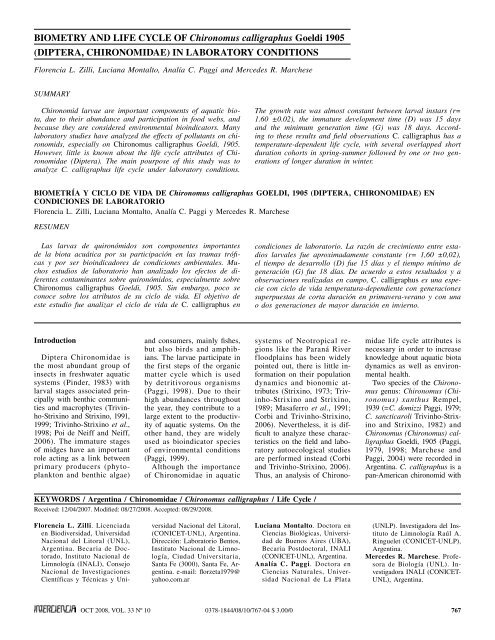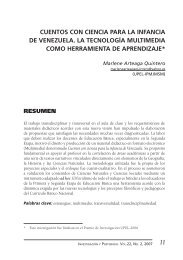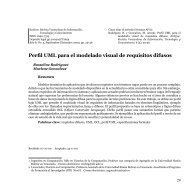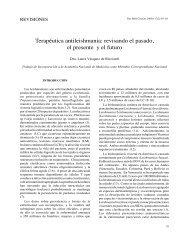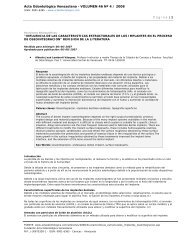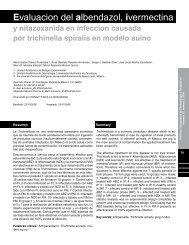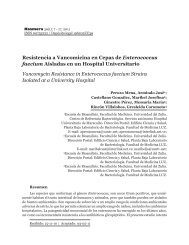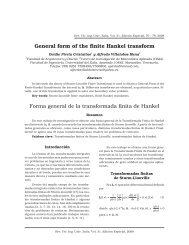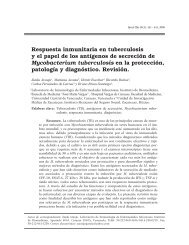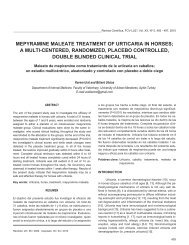BIOMETRY AND LIFE CYCLE OF Chironomus ... - SciELO
BIOMETRY AND LIFE CYCLE OF Chironomus ... - SciELO
BIOMETRY AND LIFE CYCLE OF Chironomus ... - SciELO
You also want an ePaper? Increase the reach of your titles
YUMPU automatically turns print PDFs into web optimized ePapers that Google loves.
<strong>BIOMETRY</strong> <strong>AND</strong> <strong>LIFE</strong> <strong>CYCLE</strong> <strong>OF</strong> <strong>Chironomus</strong> calligraphus Goeldi 1905<br />
(DIPTERA, CHIRONOMIDAE) IN LABORATORY CONDITIONS<br />
Florencia L. Zilli, Luciana Montalto, Analía C. Paggi and Mercedes R. Marchese<br />
SUMMARY<br />
Chironomid larvae are important components of aquatic biota,<br />
due to their abundance and participation in food webs, and<br />
because they are considered environmental bioindicators. Many<br />
laboratory studies have analyzed the effects of pollutants on chironomids,<br />
especially on <strong>Chironomus</strong> calligraphus Goeldi, 1905.<br />
However, little is known about the life cycle attributes of Chironomidae<br />
(Diptera). The main pourpose of this study was to<br />
analyze C. calligraphus life cycle under laboratory conditions.<br />
The growth rate was almost constant between larval instars (r=<br />
1.60 ±0.02), the immature development time (D) was 15 days<br />
and the minimum generation time (G) was 18 days. According<br />
to these results and field observations C. calligraphus has a<br />
temperature-dependent life cycle, with several overlapped short<br />
duration cohorts in spring-summer followed by one or two generations<br />
of longer duration in winter.<br />
BIOMETRÍA Y CICLO DE VIDA DE <strong>Chironomus</strong> calligraphus Goeldi, 1905 (DIPTERA, CHIRONOMIDAE) EN<br />
CONDICIONES DE LABORATORIO<br />
Florencia L. Zilli, Luciana Montalto, Analía C. Paggi y Mercedes R. Marchese<br />
RESUMEN<br />
Las larvas de quironómidos son componentes importantes<br />
de la biota acuática por su participación en las tramas tróficas<br />
y por ser bioindicadores de condiciones ambientales. Muchos<br />
estudios de laboratorio han analizado los efectos de diferentes<br />
contaminantes sobre quironómidos, especialmente sobre<br />
<strong>Chironomus</strong> calligraphus Goeldi, 1905. Sin embargo, poco se<br />
conoce sobre los atributos de su ciclo de vida. El objetivo de<br />
este estudio fue analizar el ciclo de vida de C. calligraphus en<br />
condiciones de laboratorio. La razón de crecimiento entre estadios<br />
larvales fue aproximadamente constante (r= 1,60 ±0,02),<br />
el tiempo de desarrollo (D) fue 15 días y el tiempo mínimo de<br />
generación (G) fue 18 días. De acuerdo a estos resultados y a<br />
observaciones realizadas en campo, C. calligraphus es una especie<br />
con ciclo de vida temperatura-dependiente con generaciones<br />
superpuestas de corta duración en primavera-verano y con una<br />
o dos generaciones de mayor duración en invierno.<br />
Introduction<br />
Diptera Chironomidae is<br />
the most abundant group of<br />
insects in freshwater aquatic<br />
systems (Pinder, 1983) with<br />
larval stages associated principally<br />
with benthic communities<br />
and macrophytes (Trivinho-Strixino<br />
and Strixino, 1991,<br />
1999; Trivinho-Strixino et al.,<br />
1998; Poi de Neiff and Neiff,<br />
2006). The immature stages<br />
of midges have an important<br />
role acting as a link between<br />
primary producers (phytoplankton<br />
and benthic algae)<br />
and consumers, mainly fishes,<br />
but also birds and amphibians.<br />
The larvae participate in<br />
the first steps of the organic<br />
matter cycle which is used<br />
by detritivorous organisms<br />
(Paggi, 1998). Due to their<br />
high abundances throughout<br />
the year, they contribute to a<br />
large extent to the productivity<br />
of aquatic systems. On the<br />
other hand, they are widely<br />
used as bioindicator species<br />
of environmental conditions<br />
(Paggi, 1999).<br />
Although the importance<br />
of Chironomidae in aquatic<br />
systems of Neotropical regions<br />
like the Paraná River<br />
floodplains has been widely<br />
pointed out, there is little information<br />
on their population<br />
dynamics and bionomic attributes<br />
(Strixino, 1973; Trivinho-Strixino<br />
and Strixino,<br />
1989; Masaferro et al., 1991;<br />
Corbi and Trivinho-Strixino,<br />
2006). Nevertheless, it is difficult<br />
to analyze these characteristics<br />
on the field and laboratory<br />
autoecological studies<br />
are performed instead (Corbi<br />
and Trivinho-Strixino, 2006).<br />
Thus, an analysis of Chirono-<br />
midae life cycle attributes is<br />
necessary in order to increase<br />
knowledge about aquatic biota<br />
dynamics as well as environmental<br />
health.<br />
Two species of the <strong>Chironomus</strong><br />
genus: <strong>Chironomus</strong> (<strong>Chironomus</strong>)<br />
xanthus Rempel,<br />
1939 (=C. domizzi Paggi, 1979;<br />
C. sancticaroli Trivinho-Strixino<br />
and Strixino, 1982) and<br />
<strong>Chironomus</strong> (<strong>Chironomus</strong>) calligraphus<br />
Goeldi, 1905 (Paggi,<br />
1979, 1998; Marchese and<br />
Paggi, 2004) were recorded in<br />
Argentina. C. calligraphus is a<br />
pan-American chironomid with<br />
KEYWORDS / Argentina / Chironomidae / <strong>Chironomus</strong> calligraphus / Life Cycle /<br />
Received: 12/04/2007. Modified: 08/27/2008. Accepted: 08/29/2008.<br />
Florencia L. Zilli. Licenciada<br />
en Biodiversidad, Universidad<br />
Nacional del Litoral (UNL),<br />
Argentina. Becaria de Doctorado,<br />
Instituto Nacional de<br />
Limnología (INALI), Consejo<br />
Nacional de Investigaciones<br />
Científicas y Técnicas y Universidad<br />
Nacional del Litoral,<br />
(CONICET-UNL), Argentina.<br />
Dirección: Laboratorio Bentos,<br />
Instituto Nacional de Limnología,<br />
Ciudad Universitaria,<br />
Santa Fe (3000), Santa Fe, Argentina.<br />
e-mail: florzeta1979@<br />
yahoo.com.ar<br />
Luciana Montalto. Doctora en<br />
Ciencias Biológicas, Universidad<br />
de Buenos Aires (UBA),<br />
Becaria Postdoctoral, INALI<br />
(CONICET-UNL), Argentina.<br />
Analía C. Paggi. Doctora en<br />
Ciencias Naturales, Universidad<br />
Nacional de La Plata<br />
(UNLP). Investigadora del Instituto<br />
de Limnología Raúl A.<br />
Ringuelet (CONICET-UNLP),<br />
Argentina.<br />
Mercedes R. Marchese. Profesora<br />
de Biología (UNL). Investigadora<br />
INALI (CONICET-<br />
UNL), Argentina.<br />
OCT 2008, VOL. 33 Nº 10<br />
0378-1844/08/10/767-04 $ 3.00/0<br />
767
BIOMETRÍA E CICLO DE VIDA DE <strong>Chironomus</strong> calligraphus Goeldi, 1905 (DIPTERA, CHIRONOMIDAE) EM<br />
CONDIÇÕES DE LABORATÓRIO<br />
Florencia L. Zilli, Luciana Montalto, Analía C. Paggi e Mercedes R. Marchese<br />
RESUMO<br />
As larvas de quironomídeos são componentes importantes da<br />
biota aquática por sua participação nas tramas tróficas e por<br />
serem bioindicadores de condições ambientais. Muitos estudos<br />
de laboratório têm analisado os efeitos de diferentes contaminantes<br />
sobre quironomídeos, especialmente sobre <strong>Chironomus</strong><br />
calligraphus Goeldi, 1905. No entanto, pouco se conhece sobre<br />
os atributos de seu ciclo de vida. O objetivo deste estudo foi<br />
analisar o ciclo de vida de C. calligraphus em condições de<br />
laboratório. A razão de crescimento entre estágios larvais foi<br />
aproximadamente constante (r= 1,60 ±0,02), o tempo de desenvolvimento<br />
(D) foi de 15 dias e o tempo mínimo de geração (G)<br />
foi de 18 dias. De acordo a estes resultados e a observações realizadas<br />
em campo, C. calligraphus é uma espécie com ciclo de<br />
vida temperatura-dependente com gerações superpostas de curta<br />
duração em primavera-verão e com uma ou duas gerações de<br />
maior duração no inverno.<br />
a predominantly Neotropical<br />
distribution. This<br />
species was reported to<br />
have a high potential as<br />
a nuisance to humans in<br />
the USA, mainly because<br />
it has the ability to thrive<br />
in a wide range of conditions<br />
and habitats, including<br />
small and temporary<br />
waters (Spies, 2000;<br />
Spies et al., 2002). There<br />
are reports about its morphology<br />
(Goeldi, 1905; Roback,<br />
1962; Fittkau, 1965; Paggi,<br />
1979; Spies et al., 2002), karyology<br />
and DNA sequencing<br />
(Spies et al., 2002) as well as<br />
many ecotoxicology test studies<br />
(Iannacone and Alvariño,<br />
1998; Iannacone and Dale,<br />
1999; Iannacone et al., 1999),<br />
but there is no available information<br />
about the life cycle of<br />
this species. The present study<br />
provides information about the<br />
life cycle of C. calligraphus<br />
under laboratory conditions.<br />
Methods and Material<br />
Sampling<br />
Egg masses of <strong>Chironomus</strong><br />
calligraphus Goeldi, 1905<br />
were collected in field waters<br />
of Santo Tomé city (Santa<br />
Fe, Argentina, 31°40’2.54”S<br />
and 60°45’13.09”W) in January<br />
2007 and transported to<br />
the laboratory, conditioned in<br />
recipients with environmental<br />
water at 21.8 ±3.2ºC.<br />
Laboratory rearing<br />
The egg masses were placed<br />
in Petri dishes and left up to<br />
Figure 1. <strong>Chironomus</strong> calligraphus at larval instar IV. a: head capsule, ventral view, b: larva, lateral view.<br />
the moment when the first<br />
instar left the mucilaginous<br />
mass that served for its nutrition.<br />
The number of eggs per<br />
mass, and the width (µm) and<br />
length (µm) of each egg were<br />
measured under an optic microscope.<br />
After that period, the<br />
larvae were separated and<br />
cultured individually in 10<br />
plastic aquaria (12×21×6cm)<br />
with permanently oxygenated<br />
water (1 lit) at room<br />
temperature. The larvae were<br />
fed with a finely ground suspension<br />
of flaked fish food<br />
(TetraMin ® , Germany) every<br />
two days. Larvae were<br />
collected daily from each<br />
aquarium and the aquaria<br />
were kept covered to retain<br />
the adults at emergence. The<br />
air temperature of 22.5-31ºC<br />
held throughout the duration<br />
of the study.<br />
Life cycle and larval instars<br />
The collected larvae (Figure<br />
1) were fixed and conserved in<br />
70% alcohol. The larvae head<br />
capsule width (maximum ventral<br />
width of the cephalic capsule<br />
measured transversely to<br />
the major body axis) and the<br />
total body length (from the<br />
anterior margin of the cephalic<br />
capsule to the final portion<br />
of the last abdominal segment)<br />
were measured (µm) using an<br />
optic microscope with a micrometric<br />
scale. A population<br />
growth curve showing the relationship<br />
between total body<br />
length (µm) and time (days)<br />
was obtained. The larvae were<br />
separated into instars according<br />
to the relationship between<br />
head capsule width and total<br />
body length. In order to determine<br />
the growth rate between<br />
instars, the Dyar proportion<br />
(r; Dyar, 1890) was calculated<br />
considering its widespread application<br />
in arthropods (Strixino,<br />
1973).<br />
The time up to eclosion, the<br />
mean duration of each instar,<br />
the immature development<br />
time D (average time from<br />
egg deposition to adult emergence,<br />
when females were<br />
available; Danks, 2006), the<br />
minimum generation time G<br />
(mean interval from oviposition<br />
to the first progeny of the<br />
next generation; Danks, 2006)<br />
and the mean generation time<br />
(G) of the population by determining<br />
the lasting time of<br />
emergence, were recorded.<br />
The studied material was deposited<br />
at the Instituto de Limnología<br />
Dr. Raúl A. Ringuelet,<br />
La Plata, Argentina.<br />
Results and Discussion<br />
The eggs measured 317.7<br />
±20.0µm in length and 119.1<br />
±10.3µm in width. The range<br />
of variation in the number<br />
of eggs per mass (369-374)<br />
was lower than that registered<br />
for tropical C. xanthus (500-<br />
1045) by Trivinho-Strixino<br />
and Strixino (1982). In this<br />
sense, subtropical C. calligraphus<br />
could have improved its<br />
fitness by increasing the size<br />
of each egg rather than the<br />
number. The hatching period<br />
was of approximately 3 days.<br />
The larval instars were<br />
clearly separated when measuring<br />
the head capsule width<br />
to total body length relation<br />
(Figure 2). The data collected<br />
about mean head capsule<br />
width, total body length,<br />
growth rate and duration of<br />
the different larval instars of<br />
C. calligraphus is summarized<br />
in Table I. In the second<br />
instar the larvae showed a<br />
bottom exploratory behavior<br />
and constructed the tubes.<br />
They also started to develop<br />
the tubules of the eight segments.<br />
768 OCT 2008, VOL. 33 Nº 10
Figure 2. Relationship between head capsule width (µm) and total body<br />
length (µm) of <strong>Chironomus</strong> calligraphus larval instars I to IV.<br />
The r (Dyar) values obtained<br />
were almost constant<br />
(1.60 ±0.02) showing the accuracy<br />
of this method in the<br />
determination of C. calligraphus<br />
larval growth rate. This<br />
value was lower than that reported<br />
for C. xanthus (1.70<br />
±0.032) by Trivinho-Strixino<br />
and Strixino (1982). The possibility<br />
of using Dyar r values<br />
is important for benthos,<br />
as for those insects developing<br />
some immature stages<br />
on macrophytes, being less<br />
probable to find the first instar<br />
in the field, measures can be<br />
estimated trough the r value<br />
instead (Strixino, 1973).<br />
The regression model<br />
that best fitted for the relationship<br />
between total<br />
body length and time was<br />
y= 9536.6+(1177.8-9536.6)/<br />
(1+(x/6.8) 5.1 ) (R² = 0.987),<br />
showing that size increased<br />
continuously until reaching<br />
an asymptote near the 15 th<br />
day, remaining almost constant<br />
thereafter (Figure 3).<br />
C. calligraphus larvae incremented<br />
their size mostly in<br />
the earlier instars (I and II:<br />
120.8%; II and III: 109.0%)<br />
while a smaller increment<br />
(74.6%) took place between<br />
instars III and IV. The total<br />
growth (instars I-IV) represented<br />
an increment of<br />
706.2%.<br />
Instar I lasted 5 ±1.2 days,<br />
with 1-2 days developing inside<br />
the mucilaginous hatching<br />
mass. Instar II lasted 3<br />
±0.7 days and instar III, 6<br />
±2.6 days. Instar IV lasted 10<br />
±1.7 days, with approximately<br />
8 days corresponding to the<br />
transitional stage between larva<br />
and pupa (commonly called<br />
pre-pupa), probably due to the<br />
fact that the changes occurring<br />
in this metamorphosis step require<br />
a large amount of extra<br />
energy supply. The pupa stage<br />
lasted 10 ±2.4 days and each<br />
TABLE I<br />
MEAN (±SD) HEAD CAPSULE WIDTH, GROWTH RATE, TOTAL BODY LENGTH <strong>AND</strong><br />
DURATION <strong>OF</strong> LARVAL INSTARS <strong>OF</strong> <strong>Chironomus</strong> calligraphus<br />
Instars<br />
Head capsule<br />
width (µm)<br />
Growth rate<br />
(r)<br />
Total body<br />
length (µm)<br />
Duration<br />
(days)<br />
I 115.2 ±6.9 1.58 1109.3 ±193.4 5 ±1.2<br />
II 182.2 ±10.8 1.62 2449.1 ±701.4 3 ±0.7<br />
III 295.3 ±19.1 1.60 5121.1 ±750.7 6 ±2.6<br />
IV 472.8 ±30.9 1.60 8943.6 ±1672.7 10 ±1.7<br />
Figure 3. Relationship between total body length<br />
(µm) and time (days) of <strong>Chironomus</strong> calligraphus<br />
larval instars I to IV. The approximate average<br />
duration of instars is indicated.<br />
Figure 4. Overlap between <strong>Chironomus</strong> calligraphus instars. The additional<br />
life time of emerged adults is shown as a pointed line. E: egg;<br />
Ll-LIV: larval instars I to IV; P: pupa, A: adult. The pre-pupa stage<br />
is also indicated.<br />
pupa remained in the tube of<br />
the last larval instar (IV) for<br />
1 or 2 days after it swam to<br />
the surface, where the imago<br />
emerged in only a few minutes<br />
and lived without feeding<br />
for 2 or 3 days. The minimum<br />
immature development time<br />
(D) was of 15 days and the<br />
minimum time to complete<br />
a generation (G) was of 18<br />
days. Thus, as emergence took<br />
an average time of 10 days<br />
(with the highest emergences<br />
between the 18 th and 22 nd day),<br />
the average generation time<br />
(G) was of 23 (18-28) days.<br />
In the earlier stages overlapping<br />
was low, with a synchronization<br />
of larval instars<br />
(Figure 4). In the last days of<br />
the cycle an overlap was registered,<br />
when instar IV larvae<br />
(mostly as pre-pupa), pupae<br />
and adults coexisted. For C.<br />
xanthus, Trivinho-Strixino and<br />
Strixino (1982) pointed out<br />
that at high temperature (25°C<br />
constant temperature) the fast<br />
development of larvae tends to<br />
become synchronized, favoring<br />
a short emergence (3 days). In<br />
the present case, although the<br />
air temperature was in general<br />
>25°C, the overlap in the last<br />
immature stages favored long<br />
emergence duration.<br />
Many factors, such as phylogeny,<br />
resource availability,<br />
competence and interference<br />
phenomenon, temperature,<br />
habitat stability, etc. may determine<br />
and affect the development<br />
of insects (Jackson and<br />
Sweeney, 1995; Danks, 2006).<br />
The short duration of the life<br />
cycle insures a conspicuous<br />
population growth and increases<br />
insect fitness. The cycle<br />
is considered as short when<br />
it lasts
life cycle of C. calligraphus,<br />
its development is principally<br />
conditioned by temperature<br />
and life-cycle delays serve to<br />
adjust development so as to<br />
ensure seasonal coincidence<br />
(Danks, 2006).<br />
Therefore, subtropical C.<br />
calligraphus could be described<br />
as multivoltine, with<br />
several overlapped cohorts<br />
(at least four) of short duration<br />
at high temperatures<br />
(spring-summer) with high<br />
rates of development and an<br />
exponential population growth,<br />
followed by one or two generations<br />
of longer duration<br />
in winter, when it probably<br />
remains in a dormant stage.<br />
ACKNOWLEDGEMENTS<br />
This study was supported<br />
by a grant from Universidad<br />
Nacional del Litoral (UNL)<br />
and Consejo Nacional de Investigaciones<br />
Científicas y<br />
Técnicas (CONICET). The<br />
present paper is the Scientific<br />
Contribution N° 828 of the<br />
Instituto de Limnología “R.A.<br />
Ringuelet” (ILPLA) La Plata,<br />
Argentina.<br />
References<br />
Biever KD (1965) A rearing technique<br />
for the colonization of<br />
chironomid midges. Ann. Entomol.<br />
Soc. Am. 58: 135-136.<br />
Butler MG (1982) A 7-year life cycle<br />
of two <strong>Chironomus</strong> species<br />
in arctic Alaskan tundra ponds<br />
(Diptera: Chironomidae). Can.<br />
J. Zool. 60: 58-70.<br />
Corbi JJ, Trivinho-Strixino S<br />
(2006) Ciclo de vida de duas<br />
espécies de Goeldichironomus<br />
(Diptera, Chironomidae). Rev.<br />
Bras. Entomol. 50: 72-75.<br />
Danks HV (2006) Short life cycles<br />
in insects and mites. Can. Entomol.<br />
138: 407-463.<br />
Dyar HG (1890) The number of<br />
molts of Lepidopterus larvae.<br />
Psyche 5: 420-422.<br />
Fittkau EJ (1965) Revision der von<br />
E. Goeldi aus dem Amazonasgebiet<br />
beschriebenen Chironomiden<br />
(Diptera). Chironomidenstudien<br />
X. Beitr. Neotrop.<br />
Fauna 4: 209-226.<br />
Goeldi EA (1905) Os mosquitos no<br />
Pará. Mem. Mus. Para. Hist.<br />
Nat. Etnol. 4: 134-139.<br />
Iannacone JA, Alvariño L (1998)<br />
Acute ecotoxicity of the organophosphate<br />
insecticide temephos<br />
to <strong>Chironomus</strong> calligraphus<br />
Goeldi (Diptera: Chironomidae).<br />
Acta Entomol. Chil.<br />
22: 53-55.<br />
Iannacone JA, Dale WE (1999)<br />
Protocolo de bioensayo ecotoxicológico<br />
para evaluar metales<br />
pesados contaminantes de<br />
agua dulce con <strong>Chironomus</strong><br />
calligraphus (Diptera: Chironomidae)<br />
y Moina macrocopa<br />
(Crustacea: Cladocera), en el<br />
Río Rímac. Lima, Perú. Rev.<br />
Per. Entomol. 41: 111-120.<br />
Iannacone JA, Alvariño L, Gutiérrez<br />
A (1999) Cinco ensayos<br />
ecotoxicológicos para evaluar<br />
metales pesados en el agua<br />
dulce. Bol. Soc. Quím. Perú<br />
65: 30-45.<br />
Jackson JK, Sweeney BW (1995)<br />
Egg and larval development<br />
times for 35 species of tropical<br />
stream insects from Costa<br />
Rica. J. North. Am. Benthol.<br />
Soc. 14: 115-130.<br />
Marchese M, Paggi AC (2004) Diversidad<br />
de Oligochaeta (Annelida)<br />
y Chironomidae (Diptera)<br />
del Litoral fluvial argentino. In<br />
Aceñolaza FC (Ed.) Temas de<br />
la Biodiversidad del Litoral<br />
Fluvial Argentino. INSUGEO.<br />
Tucumán, Argentina. pp. 217-<br />
223.<br />
Masaferro J, Paggi AC, Rodrígues<br />
Capítulo A (1991) Estudio poblacional<br />
de los quironómidos<br />
(Insecta Diptera) de la laguna<br />
de Lobos, Provincia de Buenos<br />
Aires, Argentina. Graellsia 47:<br />
129-137.<br />
Paggi AC (1979) Dos nuevas especies<br />
del género Parachironomus<br />
Lenz (Diptera:<br />
Chironomidae) y nuevas citas<br />
de Quironómidos para la<br />
República Argentina. Physis<br />
38: 47-54.<br />
Paggi AC (1998) Chironomidae. In<br />
Morrone JJ, Coscarón S (Eds.)<br />
Biodiversidad de Artrópodos<br />
Argentinos. Una Perspectiva<br />
Biotaxonómica. Ediciones Sur.<br />
La Plata, Argentina. pp 327-<br />
337.<br />
Paggi AC (1999) Los Chironomidae<br />
como indicadores de calidad<br />
de ambientes dulceacuícolas.<br />
Rev. Soc. Entomol. Argent. 58:<br />
202-207.<br />
Pinder LCV (1983) The larvae of<br />
Chironomidae (Diptera) of the<br />
holartic region Introduction. In<br />
Wiederholm T (Ed.) Chironomidae<br />
of the Holartic Region:<br />
Keys and Diagnoses. Entomol.<br />
Scan. Supl. pp 7-10.<br />
Poi de Neiff A, Neiff JJ (2006)<br />
Riqueza de especies y similaridad<br />
de los invertebrados que<br />
viven en plantas flotantes de la<br />
planicie de inundación del río<br />
Paraná (Argentina). Interciencia<br />
31: 220-225.<br />
Roback SS (1962) Some new<br />
Tendypedidae from the Canal<br />
Zone. Not. Nat. 355: 1-10.<br />
Spies M (2000) Non-biting `nuisance´<br />
midges (Diptera, Chironomidae)<br />
in urban southern<br />
California, with notes on taxonomy,<br />
ecology and zoogeography.<br />
In Hoffrichter O (Ed.)<br />
Late 20 th Century Research<br />
on Chironomidae: an Anthology<br />
from 13 th International<br />
Symposium on Chironomidae.<br />
Aachen, Germany. pp.<br />
621-628.<br />
Spies M, Sublette JE, Sublette MF,<br />
Wülker WF, Martin J, Hille<br />
A, Miller MA, Witt K (2002)<br />
Pan-American <strong>Chironomus</strong> calligraphus<br />
Goeldi, 1905 (Diptera,<br />
Chironomidae): Species<br />
or complex? Evidence from<br />
external morphology, kariology<br />
and DNA sequencing. Aquat.<br />
Insects 24: 91-113.<br />
Strixino S (1973) A Largura da<br />
Cabeça na Determinação das<br />
Fases Larvais de Chironomidae<br />
na Represa do Lobo. Thesis.<br />
Universidade Federal de<br />
São Carlos. Brazil. 167 pp.<br />
Strixino G, Trivinho-Strixino S<br />
(1985) A temperatura e o desenvolvimento<br />
larval de <strong>Chironomus</strong><br />
sancticaroli (Diptera:<br />
Chironomidae). Rev. Bras.<br />
Zool. 3: 177-180.<br />
Trivinho-Strixino S, Strixino G<br />
(1982) Ciclo de vida de <strong>Chironomus</strong><br />
sancticaroli Strixino<br />
and Strixino, (Diptera, Chironomidae).<br />
Rev. Bras. Entomol.<br />
26: 183-189.<br />
Trivinho-Strixino S, Strixino G<br />
(1989) Observations on the<br />
reproductive biology of a Neotropical<br />
chironomid (Diptera,<br />
Chironomidae). Rev. Bras.<br />
Biol. 33: 207-216.<br />
Trivinho-Strixino S, Strixino G<br />
(1991) Estrutura da comunidade<br />
de insetos aquáticos associados<br />
à Pontederia lanceolata<br />
Nuttal. Rev. Bras. Biol.<br />
53: 103-111.<br />
Trivinho-Strixino S, Strixino G<br />
(1999) Insectos dípteros quironomídeos.<br />
In Ismael D, Valenti<br />
WC, Matsumura-Tundisi T,<br />
Rocha O (Eds.) Biodiversidade<br />
do Estado de São Paulo, Brasil.<br />
pp 141-148.<br />
Trivinho-Strixino S, Gessner FA,<br />
Correia L (1998) Macroinvertebrados<br />
associados a macrófitas<br />
aquáticas das lagõas marginais<br />
da Estação Ecológica de Jataí<br />
(Luiz Antônio. SP). Anais do<br />
VIII Seminário Regional de<br />
Ecologia 3: 1189-1198.<br />
770 OCT 2008, VOL. 33 Nº 10


